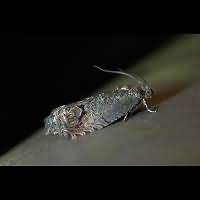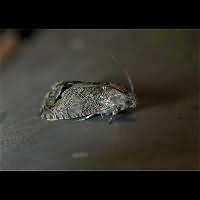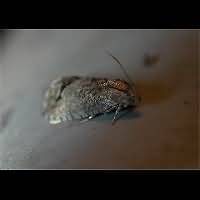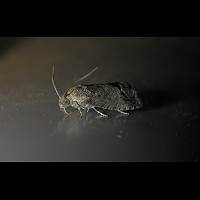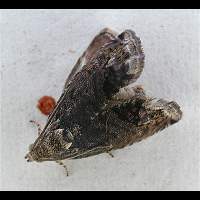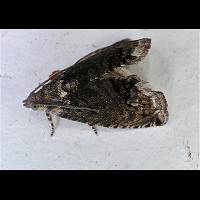Chestnut Tortrix (Cydia splendana)
The Chestnut Tortrix comes in two varieties. Most seen (up to 90% of all specimens) is the grey variety. It has some dark markings towards the end and at the front edge of the wings some waves in darker and lighter colours are visible. A minority however is very dark indeed. The grey in the wings of the usual specimens seems to have been replaced with black. You can see this variation in the bottom pictures. In both variations however the hindwings are darkbrown or almost black. The legs are greyish showing some lighter spots and bands, the antennae are also grey with white spots, especially near the base. There is no noticable difference between males and females. The variation in size is remarkable, for the wingspan may be anything between 14 and 22 mm.
In some ten days the female deposits around 60 eggs daily. The eggs are laid on the nuts, except for Chestnuts. In this case the eggs are deposited on a leaf near the growing nut. The newly hatched caterpillars bore into the nut and stay there untill it drops out of the tree. They are yellowish white and look like maggots rather than caterpillars. They are relatively short, reaching a length of no more than 13 to 15 mm. They eat the fruit from the inside, filling it up with faeces doing so. Infested fruit drops to the ground earlier than ripe, healthy ones. When the fruit drops the caterpillar will leave the nut. It usually buries a little hole in the earth to pupate, but some climb up trees to seek shelter in the bark or pupate in leaf litter. The caterpillar spins a darkbrown cocoon before pupating. The pupa, which is only about 1 centimeter long, overwinters. In spring next year the first new born adults appear. It is remarkable that the males live longer than the females do (usually this is just the other way around) and do not eat at all. The host plants of this species are oak, wallnut trees and chestnuts, including the edible varieties. In Southern Europe they became a big pest in chestnuts, while wallnuts are infected more northwards.
To fight this insect pheromones are used to lure them. Chemicals however are also still used regularly, especially in Southern Europe. Because they lead such a sheltered life, the caterpillars and pupa are popular among the parasitic flies and wasps. Adults rest on trunks and leaves during the day. They start flying in dusk and remain active till midnight. Often males will swarm in large numbers. The Chestnut Tortrix is hardly ever attracted by light and if so in very small numbers only. This is a very common species in light forests and plantations of chestnut or wallnut. Common all over Europe, including most of Russia. Also found in parts of Iran. In the USA and Canada nuts imported from Europe are always checked for the presence of this (and similar) species. The former scientific name of Laspeyresia splendana is still used regularly.
N.B. This species is also known as the Nut Fruit Tortrix and the Acorn Moth.
The Chestnut Tortrix comes in two varieties. Most seen (up to 90% of all specimens) is the grey variety. It has some dark markings towards the end and at the front edge of the wings some waves in darker and lighter colours are visible. A minority however is very dark indeed. The grey in the wings of the usual specimens seems to have been replaced with black. You can see this variation in the bottom pictures. In both variations however the hindwings are darkbrown or almost black. The legs are greyish showing some lighter spots and bands, the antennae are also grey with white spots, especially near the base. There is no noticable difference between males and females. The variation in size is remarkable, for the wingspan may be anything between 14 and 22 mm.
In some ten days the female deposits around 60 eggs daily. The eggs are laid on the nuts, except for Chestnuts. In this case the eggs are deposited on a leaf near the growing nut. The newly hatched caterpillars bore into the nut and stay there untill it drops out of the tree. They are yellowish white and look like maggots rather than caterpillars. They are relatively short, reaching a length of no more than 13 to 15 mm. They eat the fruit from the inside, filling it up with faeces doing so. Infested fruit drops to the ground earlier than ripe, healthy ones. When the fruit drops the caterpillar will leave the nut. It usually buries a little hole in the earth to pupate, but some climb up trees to seek shelter in the bark or pupate in leaf litter. The caterpillar spins a darkbrown cocoon before pupating. The pupa, which is only about 1 centimeter long, overwinters. In spring next year the first new born adults appear. It is remarkable that the males live longer than the females do (usually this is just the other way around) and do not eat at all. The host plants of this species are oak, wallnut trees and chestnuts, including the edible varieties. In Southern Europe they became a big pest in chestnuts, while wallnuts are infected more northwards.
To fight this insect pheromones are used to lure them. Chemicals however are also still used regularly, especially in Southern Europe. Because they lead such a sheltered life, the caterpillars and pupa are popular among the parasitic flies and wasps. Adults rest on trunks and leaves during the day. They start flying in dusk and remain active till midnight. Often males will swarm in large numbers. The Chestnut Tortrix is hardly ever attracted by light and if so in very small numbers only. This is a very common species in light forests and plantations of chestnut or wallnut. Common all over Europe, including most of Russia. Also found in parts of Iran. In the USA and Canada nuts imported from Europe are always checked for the presence of this (and similar) species. The former scientific name of Laspeyresia splendana is still used regularly.
N.B. This species is also known as the Nut Fruit Tortrix and the Acorn Moth.

